![]()

![]()
POWER WHEREVER YOU NEED IT!
E-Air Electric VSD Compressors
The new E-Air VSD Atlas Copco compressors redefine performance, efficiency, and versatility.
E-Air compressors are easy to install and operate.
VSD motors are powerful, streamlined, quiet, and energy-efficient.
Low emissions, low noise levels, and a plug-and-play design.
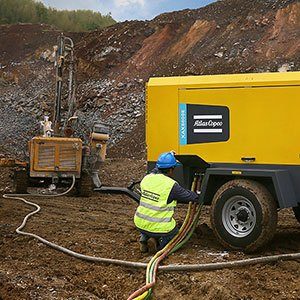
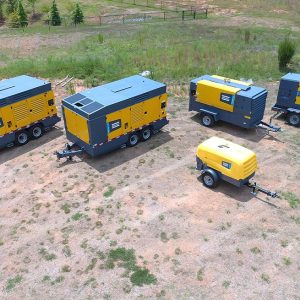
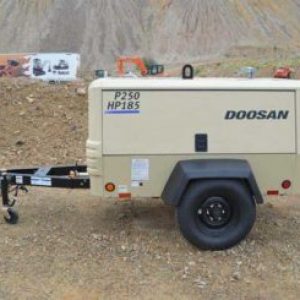

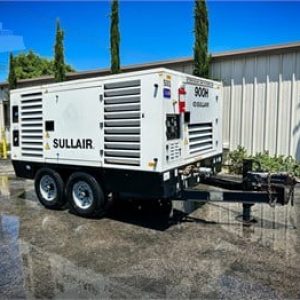
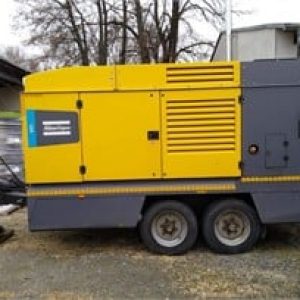
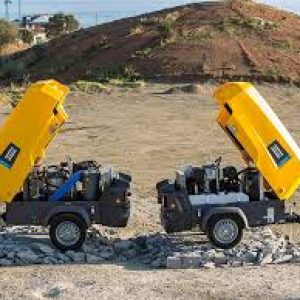



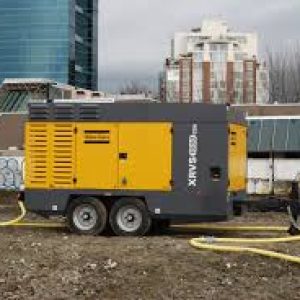
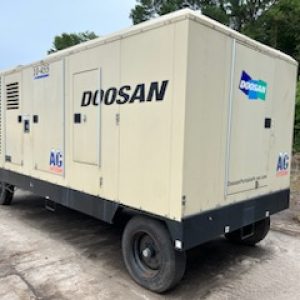
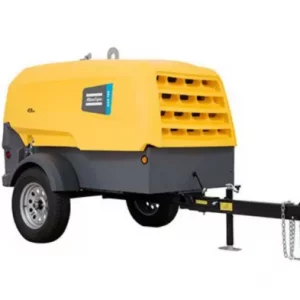
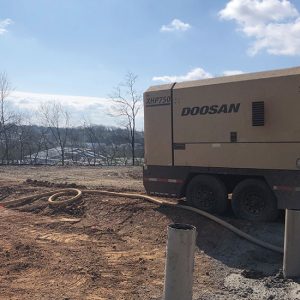
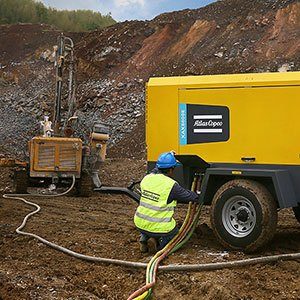
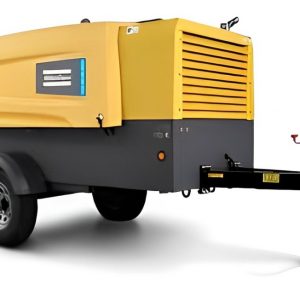
Power On-the-Go: Diesel Portable Air Compressors
XAS Series 190 - 240 CFM
Towable Air Compressors
- Sizes: 110 CFM – 230 CFM
- Pressure: 30 PSI – 150 PSI
XAS Series 365 - 410 CFM
Mobile Air Compressors
- Sizes: 365 CFM – 865 CFM
- Pressure: 100 PSI – 250 PSI
XAS Series 750 - 1800 CFM
Portable Air Compressors
- Sizes: 750 CFM – 1800 CFM
- Pressure: 100 PSI – 200 PSI
High-Pressure Anywhere:
Portable Power for Demanding Applications
V21 725 CFM High Pressure
Portable Compressor
- Air Delivery: 725 CFM – 758 CFM
- Pressure: 232 PSI – 362 PSI
- Features: Pace Technology
XRVS 1000 CFM High Pressure Portable Compressor
- Air Delivery: 911 CFM – 1136 CFM
- Pressure: 218 PSI – 508 PSI
- Features: Pace Technology
XRVS 1550 CFM High Pressure Portable Compressor
- Air Delivery: 1350 CFM – 1550 CFM
- Pressure: 246 PSI – 508 PSI
- Features: Pace Technology
E-AIr VSD - Electric Mobile Air Compressors
H185 CFM - H250 CFM Variable Speed Portable Compressor
- Air Delivery: 131 CFM – 233 CFM
- Pressure: 72 PSI – 174 PSI
H450 CFM Variable Speed
Portable Compressor
- Air Delivery: 360 CFM – 466 CFM
- Pressure: 72 PSI – 190 PSI
V1100 CFM Variable Speed
Portable Compressor
- Air Delivery: 790 CFM – 1285 CFM
- Pressure: 72 PSI – 203 PSI
Frequently Asked Questions
Portable air compressors enhance job site efficiency by providing immediate access to compressed air, which powers tools and equipment, ensuring that tasks can be completed quickly and effectively. molecules are condensed and pressurized.
When selecting a portable air compressor, look for features such as a high CFM (cubic feet per minute) rating, durable construction, ease of transport, reliable power sources (gasoline or diesel), and safety features like thermal overload protection.
Consider the noise level of the compressor, especially if you’ll be using it in residential areas or indoors, as quieter models can prevent disturbances and comply with noise regulations.
Look for a compressor with multiple outlets if you need to run several tools simultaneously, ensuring it can handle the combined demand without losing performance.
A portable air compressor is ideal for projects requiring mobility, as it allows you to move the compressor to different locations easily, unlike a stationary model which is fixed in one place and may require extensive setup for different job sites.
Portable air compressors are generally more compact and easier to store when not in use, making them ideal for smaller workshops or job sites with limited space.
They often require less initial setup and can be quickly deployed, making them suitable for short-term projects or emergency situations where time is critical.
Portable air compressors enhance industrial operations by providing on-the-go power for pneumatic tools, reducing the need for multiple stationary units, and ensuring that compressed air is available wherever it is needed on-site.
Portable air compressors are versatile and can be used in a wide range of applications across various industries. Here are some of the most ideal applications:
1. Construction and Demolition
- Pneumatic Tools: Powering nail guns, jackhammers, drills, impact wrenches, and sanders.
- Blasting and Cleaning: Providing compressed air for sandblasting surfaces and cleaning debris from construction sites.
2. Automotive Industry
- Tire Inflation: Inflating tires quickly and efficiently.
- Air Tools: Operating air-powered tools like spray guns, impact wrenches, and air ratchets for repairs and maintenance.
- Painting: Providing a steady supply of air for auto body painting.
3. Manufacturing and Fabrication
- Assembly Lines: Running pneumatic tools for assembling products.
- Metalworking: Powering plasma cutters, grinders, and sanders.
- Packaging: Operating pneumatic machinery for sealing, filling, and labeling products.
4. Agriculture
- Crop Spraying: Supplying air for pesticide and fertilizer sprayers.
- Livestock Maintenance: Cleaning barns and feeding equipment.
- Irrigation Systems: Providing power for irrigation pumps and systems.
5. Emergency Services
- Rescue Operations: Using air compressors to power rescue tools like air jacks and cutters.
- Disaster Relief: Providing a portable power source for pneumatic tools during emergency repairs and relief efforts.
6. Home and DIY Projects
- Tool Operation: Powering tools such as nail guns, staplers, and spray guns for home improvement and renovation projects.
- Inflation: Inflating tires, sports equipment, and inflatable toys or furniture.
7. Painting and Finishing
- Professional Painting: Supplying air for paint sprayers in residential, commercial, and industrial painting jobs.
- Surface Preparation: Powering sandblasters and grinders for preparing surfaces before painting.
8. Landscaping and Gardening
- Power Tools: Running pneumatic tools like trimmers, edgers, and blowers.
- Irrigation Systems: Supporting air-powered irrigation systems and equipment.
9. Mining and Quarrying
- Drilling: Operating pneumatic drills and hammers for extracting minerals and ores.
- Maintenance: Cleaning and maintaining mining equipment and sites.
10. Marine Industry
- Maintenance: Powering tools for ship maintenance and repairs.
- Painting and Sandblasting: Providing air for painting ship hulls and sandblasting rust and old paint.
11. Energy Sector
- Pipeline Maintenance: Operating pneumatic tools for maintaining and repairing pipelines.
- Oil and Gas Extraction: Supporting drilling and extraction operations with air-powered equipment.
12. Event Setup
- Inflation: Inflating large event structures like bounce houses, inflatable tents, and advertising balloons.
- Power Tools: Assisting in the setup and teardown of event equipment with air-powered tools.
13. Medical and Healthcare
- Emergency Services: Supporting pneumatic rescue tools in ambulances and emergency vehicles.
- Medical Equipment: Providing compressed air for various medical devices and equipment.
14. Recreational Use
- Sports Events: Inflating sports equipment like soccer balls, basketballs, and inflatable play structures.
- Camping: Powering portable air mattresses and other inflatable camping gear
Proper maintenance and care are essential for ensuring the longevity and efficient operation of your portable air compressor. Here are the key steps to maintain and care for your unit:
1. Regular Inspection
- Visual Check: Inspect the compressor regularly for any signs of wear and tear, leaks, or damage to hoses, fittings, and other components.
- Connections: Ensure all connections are tight and secure to prevent air leaks.
2. Check and Change the Oil (if applicable)
- Oil Level: Regularly check the oil level in the compressor, and top it up if necessary.
- Oil Change: Change the oil according to the manufacturer’s recommendations. Typically, this should be done after the first 20-50 hours of use and then every 200-500 hours of operation.
3. Drain the Air Tank
- Daily Drainage: Drain the air tank after each use to remove moisture that accumulates from the compressed air. This helps prevent rust and corrosion inside the tank.
- Automatic Drain Valve: Consider installing an automatic drain valve to simplify this process.
4. Clean or Replace Air Filters
- Filter Inspection: Check the air filters regularly and clean or replace them as needed. Dirty filters can reduce efficiency and cause the compressor to overheat.
- Frequency: Replace filters every 3-6 months or according to the manufacturer’s recommendations.
5. Inspect and Clean the Intake Vents
- Vents: Keep the intake vents clean and free of dust and debris. Blocked vents can cause the compressor to overheat.
- Frequency: Clean the vents monthly or more often if operating in a dusty environment.
6. Check Belts (if applicable)
- Belt Tension: Inspect the belts for proper tension and alignment. Loose or worn belts should be adjusted or replaced.
- Wear and Tear: Check for cracks or fraying and replace any damaged belts.
7. Test the Safety Valve
- Regular Testing: Test the safety valve to ensure it’s functioning properly. Pull the valve ring to release air and make sure it resets correctly.
- Frequency: Test the valve monthly or as recommended by the manufacturer.
8. Inspect Hoses and Connections
- Hose Condition: Check hoses for cracks, leaks, or wear. Replace damaged hoses immediately.
- Connections: Ensure all connections are secure and free from leaks.
9. Check Electrical Components (for electric compressors)
- Cords and Plugs: Inspect power cords and plugs for damage. Replace any damaged components to avoid electrical hazards.
- Connections: Ensure all electrical connections are tight and secure.
10. Clean the Exterior
- Regular Cleaning: Keep the exterior of the compressor clean to prevent dust and debris from entering the internal components.
- Wipe Down: Use a damp cloth to wipe down the exterior surfaces regularly.
11. Store Properly
- Dry Environment: Store the compressor in a dry, clean, and well-ventilated area to prevent rust and damage.
- Cover: Use a cover to protect the compressor from dust and debris when not in use.
12. Follow the Manufacturer’s Maintenance Schedule
- Manual: Always refer to the manufacturer’s manual for specific maintenance schedules and guidelines.
- Service: Schedule professional servicing as recommended, especially for more complex maintenance tasks.
By following these maintenance steps, you can ensure that your portable air compressor operates efficiently and has a long service life. Regular care and attention will help prevent breakdowns and costly repairs, keeping your compressor ready for use whenever you need it.
Portable air compressors come in various types, each designed to suit specific applications and requirements. Here are the main types of portable air compressors:
**1. Pancake Air Compressors:
- Description: These compressors have a flat, round storage tank mounted on the bottom of the unit.
- Features: Lightweight, compact, and easy to carry.
- Best For: Home use, light-duty tasks, inflating tires, and powering small pneumatic tools.
2. Hot Dog Air Compressors:
- Description: Named for their cylindrical shape, these compressors typically have a single, horizontal tank.
- Features: Compact, with a larger tank than pancake compressors, providing more air capacity.
- Best For: DIY projects, small woodworking tasks, and inflation.
3. Twin-Stack Air Compressors:
- Description: These compressors feature two horizontal, cylindrical tanks stacked one above the other.
- Features: Increased air storage capacity compared to single-tank models.
- Best For: Medium-duty tasks, powering multiple pneumatic tools, and small construction projects.
4. Wheelbarrow Air Compressors:
- Description: These compressors have two cylindrical tanks arranged horizontally and are equipped with wheels and a handle for easy transport.
- Features: High air capacity and mobility.
- Best For: Construction sites, roofing, and framing work.
5. Rotary Screw Air Compressors:
- Description: Uses a rotary-type positive-displacement mechanism with screw-shaped rotors to compress air.
- Features: Continuous airflow, high efficiency, and quieter operation.
- Best For: Industrial applications, heavy-duty continuous use, and large-scale construction projects.
6. Reciprocating (Piston) Air Compressors:
- Description: Uses a piston driven by a crankshaft to deliver air at high pressure.
- Features: Available in single-stage and two-stage configurations for different pressure requirements.
- Best For: Versatile use, automotive repair shops, small-scale manufacturing, and construction.
7. Inflators:
- Description: Compact, handheld compressors designed specifically for inflating tires, sports equipment, and inflatables.
- Features: Lightweight, highly portable, often powered by a car’s 12V outlet.
- Best For: Emergency tire inflation, sports events, and recreational activities.
8. Portable Electric Air Compressors:
- Description: Powered by electricity and available in various tank configurations (pancake, hot dog, twin-stack).
- Features: Clean operation, quieter than gas-powered models.
- Best For: Indoor use, home workshops, and areas with easy access to electrical outlets.
9. Portable Gas-Powered Air Compressors:
- Description: Powered by gasoline engines, suitable for outdoor use.
- Features: Greater mobility, suitable for remote locations without electrical power.
- Best For: Construction sites, landscaping, and remote job sites.
10. Portable Oil-Free Air Compressors:
- Description: Uses a permanently lubricated pump to deliver air without the need for oil changes.
- Features: Low maintenance, lightweight, and cleaner air output.
- Best For: Painting, food processing, medical applications, and tasks requiring oil-free air.
11. Portable Oil-Lubricated Air Compressors:
- Description: Uses oil to lubricate the pump mechanism.
- Features: Typically more durable and quieter than oil-free models, requires regular oil changes.
- Best For: Heavy-duty tasks, automotive repair, and continuous use applications.
Choosing the right type of portable air compressor depends on your specific needs, the nature of the tasks you plan to perform, and the working environment. Each type offers unique advantages that cater to different applications, ensuring you have the right tool for the job.
Selecting the right type of portable air compressor involves considering several factors related to your specific needs and the tasks you plan to perform. Here are the key steps and considerations to help you choose the appropriate portable air compressor:
1. Determine Your Application Needs
- Types of Tools and Equipment: Identify the pneumatic tools or equipment you will be using. Different tools require different amounts of air pressure (measured in PSI) and air volume (measured in CFM).
- Light-duty tools: (e.g., nail guns, staplers) generally require lower CFM and PSI.
- Heavy-duty tools: (e.g., impact wrenches, sanders) require higher CFM and PSI.
2. Calculate Air Requirements
- CFM (Cubic Feet per Minute): Determine the CFM requirements of your tools. Look at the highest CFM rating needed for your most demanding tool and add a margin for safety (usually 20-30%).
- PSI (Pounds per Square Inch): Ensure the compressor can deliver the maximum PSI required by your tools. Most light to medium-duty tools work well with 90 PSI, but some industrial applications may require higher pressure.
3. Consider the Power Source
- Electric Compressors: Ideal for indoor use where electrical outlets are available. They are quieter and cleaner.
- Gas-Powered Compressors: Suitable for outdoor or remote locations without access to electricity. They offer greater mobility but are noisier and produce exhaust fumes.
4. Evaluate the Tank Size
- Small Tanks: (1-6 gallons) Suitable for light-duty tasks and short, intermittent use.
- Medium Tanks: (7-20 gallons) Good for moderate use and small to medium projects.
- Large Tanks: (20+ gallons) Ideal for continuous, heavy-duty use and larger projects.
5. Consider Portability and Weight
- Portability: If you need to move the compressor frequently, choose a model with wheels and a handle (e.g., wheelbarrow compressors).
- Weight: Lighter compressors (like pancake or hot dog models) are easier to carry and transport.
6. Decide Between Oil-Free and Oil-Lubricated Models
- Oil-Free Compressors: Require less maintenance and are lighter. Suitable for home use, DIY projects, and environments where clean air is essential (e.g., painting, food processing).
- Oil-Lubricated Compressors: More durable and quieter but require regular oil changes. Ideal for heavy-duty, continuous use, and industrial applications.
7. Noise Levels
- Quiet Operation: If noise is a concern (e.g., in residential areas or indoor settings), look for compressors with lower decibel (dB) ratings. Oil-lubricated models tend to be quieter.
8. Additional Features
- Auto Shut-Off: Prevents the compressor from running continuously and overheating.
- Multiple Outlets: Allows you to run multiple tools simultaneously.
- Integrated Air Regulators and Gauges: Helps monitor and adjust air pressure easily.
9. Budget and Brand Reliability
- Budget: Determine your budget and find a balance between cost and quality. Investing in a reliable brand can save you money in the long run due to better performance and durability.
- Brand Reputation: Research brands and read reviews to ensure you choose a compressor known for reliability and good customer support.
Diesel-powered portable air compressors offer advantages such as high power output, fuel efficiency, durability, and the ability to operate in remote locations without access to electrical power, making them ideal for heavy-duty and outdoor applications.
They are also known for their robust construction and long lifespan, making them a cost-effective investment for industries requiring reliable and durable equipment.


